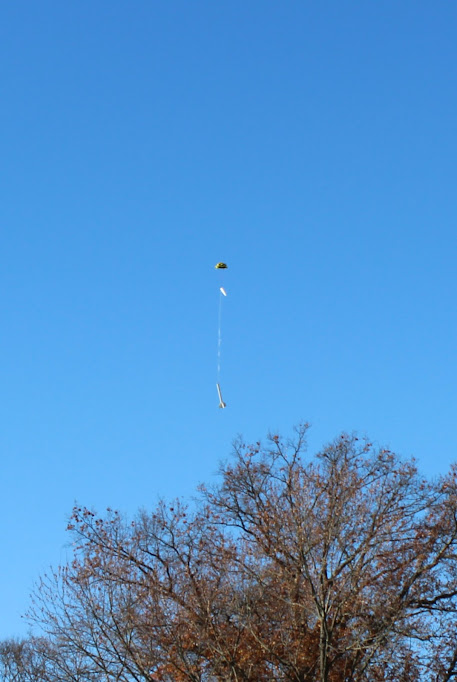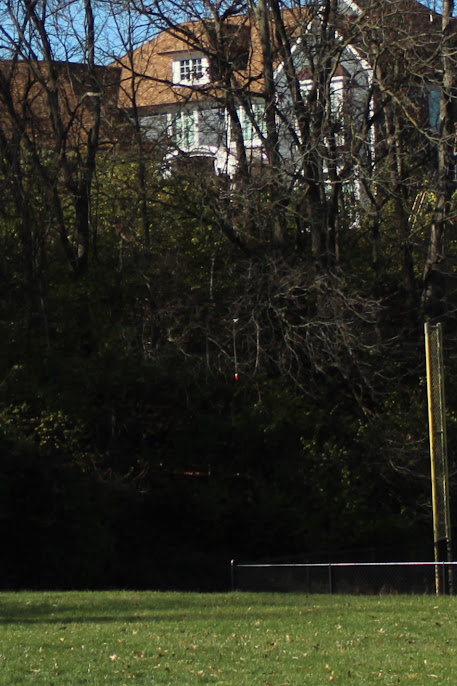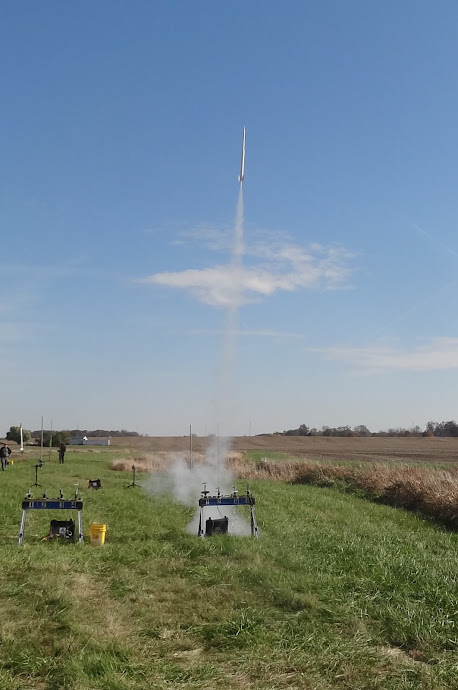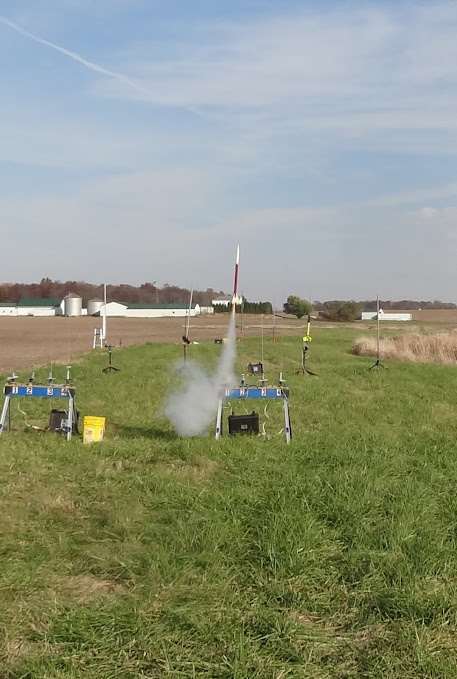Not Exactly Rocket Science
Saturday, March 16, 2024
Spring training
Tuesday, November 28, 2023
2112
First of all, I'm shocked at how washed out the yellow paint looks in this pic. Even though it is clear coated, it pops in person. This would be an A8-3 flight, as would be the two that followed. This would only be flight #3 on this version, which surprised me. Seems like I flew it more, but I could be remembering flights of v.1. This flight was off script for the afternoon, a slight bend out toward center, then a slow drift back toward the infield that ended at deep second. Altitude was short of 300', I wrote down 275', but I also wrote down that it was the best flight of the day.
Monday, November 13, 2023
More like it: 57 degree autumn launch, 11-4-23
My last launch was a little over a month ago, an 80 degree day in October where I sweated and burned like it was July. Things had changed for this launch. No shorts and a t-shirt this time. I wore jeans, a long sleeve t-shirt and a sweatshirt. I sweated and burned like it was July.
Okay, so it was windburn, and I could have taken the sweatshirt off at any time, but by the time I had reached the field I could tell the t-shirt was pretty much soaked with sweat. Layering works, but the idea is to add or subtract layers as conditions warrant, not wearing what you chose at 8am the whole day. I need to write that down. Or stitch it on a sampler.
I'd done a lot of my prep work on Thursday and Friday, choosing my victims from my spreadsheet, centering on those that had never flown, those that hadn't flown in quite a while, or those that were beanfield fliers. The Estes Pathfinder ticked two of those boxes, only because I'd built the vintage kit with an E motor mount.
As you can see, the vintage decals didn't age well. I managed to get one on, but in pieces, and I'm not about that kind of misery. In the background, you can see the unharvested corn in the fields across the road. This normally wouldn't be a big deal, as the prevailing winds normally came from our right and rockets windcocked that way. On this day, the winds were coming more from behind us, which caused any windcocking to be back over the flightline. For the most part, the field behind this photo would be the recovery area. WAY out in this field.
As expected, the Pathfinder windcocked to our six and slightly right. It tipped over at 1246' 7" and began riding the too small chute back over top of us and deep into the beans. After a recovery walk that had me seriously thinking about learning to ride a hoverboard, I found it near a plastic trash bag that the wind had left wedged under a dirt clod. All was well. Almost. The decal had partially torn away at some point during the flight. Looks like a job for CMR.
On the recovery trip, I stumbled upon a piece of rocket history. Not sure what, not sure whose, but I wracked my brain trying to remember if anything I flew had red painted ply fins.
A big part of the theme for this launch had been flying the unflown. I had a large backlog of finished or flyable rockets that I planned to bring along with me, but in the end I only wound up flying two. The Air Commander had been finished for several years. Sorry, flyable. I haven't found the time to move it to the paint queue.
This rocket has been loaded for flight for a long time. It had actually been brought to the field several times, either here in the beans or at eRockets field in Huber Heights. I thought I'd loaded it with a C11-0/C11-7 pairing, so that was what I wrote on the flight card. The announcement was greeted with shouts of "CATO TO CATO!" Alas, I had erred. It was actually a C11-0/D12-7 pairing, so there would only be one CATO. It left the pad fine, but the staging event was quite a bit more explosive than the norm. It staged with a BOOM around the 150' mark. The sustainer lit immediately and continued to fly with noticeable vigor to around 1000'. Definitely not a C11. Ejection occurred behind us on the flightline, just as the rocket tipped over. It began drifting to the expansive fields out in front of us and to our left. Another long walk. It landed deep in the beans, about fifty feet from a windblown shopping bag that the wind brought in as a directional beacon. A fin was cracked on the landing, but nothing that can't be fixed. Inside I found the expected D12-7.

So, flight #3 would be the Advanced Rocketry Group - Black Brant IVB-30 (Hawaii), a long ago NARCON purchase that last flew in 2006. On the first flight it broke the tip off the nose cone during recovery, and short of buying another kit, I couldn't figure a way to replace it. I improvised. It's no longer as pointy as it had been, but I'm good with that.
The first flight in 2006 was on an E9-8, and I was convinced that the long delay was the cause of the broken nose cone tip. The flight was huge, as was the recovery drift, so much so that I drove to the landing site. This flight would be on an E12-6 and would be equally as huge. I estimated 1126', 31". Give or take a meter. As did the others, it left the pad and headed into the wind, over and behind the flightline, but not enough to make the recovery walk more manageable.
The Estes Stratocruiser D would be next on the pad. Stratocruiser was Estes name, I added the D. I picked up a couple during an Estes closeout and at some point, opened this one to scavenge the motor mount for another project. Sometime later, I decided to pair the orphaned Stratocruiser with a similarly orphaned D motor mount. So, the Stratocruiser D was born on a night when I had nothing better to do than build something that was lying around minding its own business. I liked the looks of the Stratocruiser, and with the D power, it immediately elevates itself out of the B6-4 Field realm.
There should be flight pics. Really. If you know of them, please let me in on the secret. I was convinced that I had my old trusty Sony back in service, but that seems to have not been the case. This would not be the only flight of the day that had this issue. The flight was pretty standard, a straight boost, minimal windcocking back over the flightline, then a recovery deep in the beans. I estimates 1000', but it could have been 996'.
My fifth flight would be another Estes bird, the Hi Flier XL, and this time the camera worked. This rocket hadn't flown since 2017, and that had been the first flight. I must have had quite the backlog of big birds
for this not to have flown in the beans in six years.
This was a cookie-cutter flight on an E12-6, straight boost with windcocking back over and behind the flightline, but not far enough to make one think about driving after it instead of making the walk. Not the most adventurous recovery, that was still to come, but it was the longest. I didn't make it to the farm buildings in the background, but I overflew the directional bag by a hundred yards plus.
Jerry Irvine passed recently, which made the next flight a must. Not only had it not flown since 2017, I'd never really fed it all the onions. The Sniper was my first USR kit, and introduced me to a couple of the peculiarities of a Jerry designed kit. As USR kits go, this is the best-looking design and name combination in the catalog, but I made a couple of changes during the build. I swapped out the stubby nose cone for a sleeker one, I printed off a transition instead of using the "cut and bend the body tube" transition, and I swapped in a 24mm motor mount instead of the 29mm minimum diameter that Jerry was convinced this should fly on. Jerry's nose was a bit out of joint, but he still used my image in his online catalog.
So, no E16-6 for this flight, but an E12-6 should still make for high entertainment value, right? And then some. The Sniper flight was exactly like every other flight I made on the day, with one huge exception. Boost was excellent, a gentle arc back over the flightline to about 1200'. I saw the tracking smoke, then nothing. Luckily, younger eyes were present among the spectators. A couple of people were able to track it as it came back across the field. I never saw a thing. There is an unharvested field of corn across the road from us, and the Sniper was obviously heading that way. One of the guys claimed to have seen it drop into the corn behind a white pole 5 to 10 rows deep. I never saw a thing.
Still, I felt like I had to at least make an attempt at finding it for form's sake. I headed straight for the white pole, carefully lined up the entrance to the corn, and pushed my way into the stalks. This was my first trip into the corn since my first NARAM in 2001, but I was having my doubts as to what kind of success I was going to have this time. I walked five rows deep and found a small path between the sections, looked up, and two rows further in saw my red parachute draped over the cornstalks.
Up next was the SLS Goblin. This was last flown in 2015 back in the day when Hobby Lobby was still selling 29mm BP motors and looked like they would be forever. Fool me, I don't know, four or five times, shame on me. Not long after I built a bunch of rockets for the 29mm motors, HL discontinued them. I still have a few scattered around, and actually found one in a Coaster Space Probe yesterday. The big Goblin also had one loaded, a rather optimistic F15-6. "Fly it!" my tiny walnut-sized brain said. So, here we are.
At this point on the day I was approaching 13,000 steps on the FitBit. I was hurting, but I still had motors to burn. I decided to make one more flight and see how things felt after that. Flight #8 on the day would be an Estes Sandhawk that I had picked up in an eBay auction back when old rockets were bought at estate sales and sold as a group. I don't remember what other birds came packaged with this one, but I know it would be the first flight since I bought it back in 2013.
This would be a D12-5 flight, and I was hoping it would keep things a little closer than most of the others. Turns out I was half right. I angled the rod to get a bit more cross-creek action to go along with the windcocking that would certainly take it behind the flightline. I was spot on, as the Sandhawk creaked and groaned its old carcass off the pad and across the creek. Okay, so the creaking and groaning was me, but still. Everything was fine until ejection, when the ejection charge snapped the shock cord like it was a strand of sewing thread. The body tube and fin can started free-falling toward our side of the creek. I was going to get that back. The nose cone and parachute were a different story. The flight topped out around 800' and the vintage cone and brand new nylon chute were around 700' when they passed over the flightline. There was nothing to do but watch. I felt like Henry Blake watching his antique desk fly away under a helicopter. It was still several hundred feet in the air when I lost sight of it. Repairs have already been made, but it won't be vintage anymore.



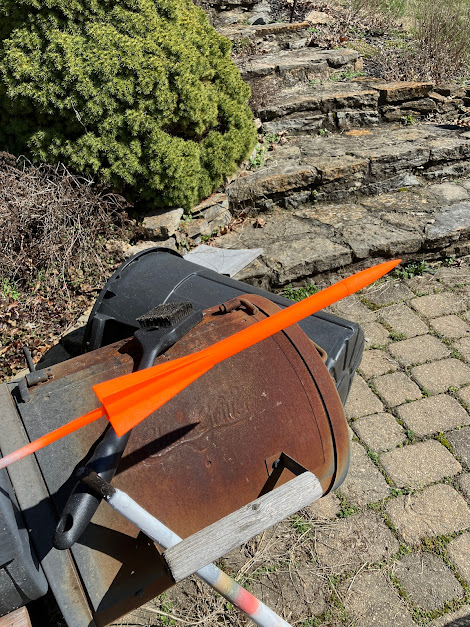








.JPG)






.JPG)




